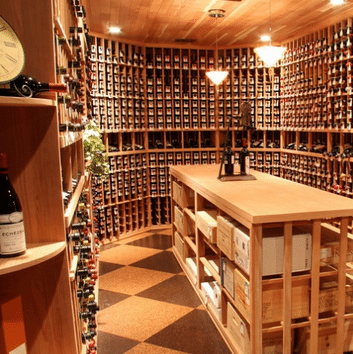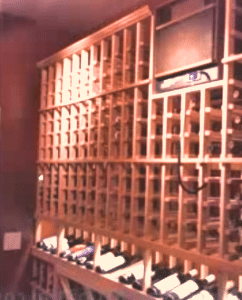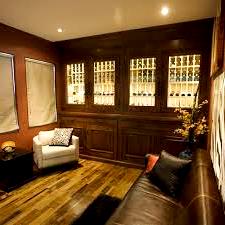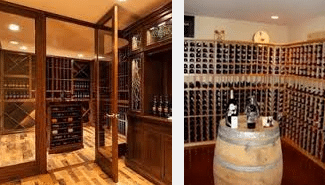Typically, people just stack bottles of wine on a counter top or have them cooled in the chiller; but, in actuality, wine requires the correct storage settings, and a common kitchen cupboard or refrigerator is not enough.
During wine cellar construction, you should focus on functionality, while making up your mind on the many things to be considered during brainstorming wine cellar design ideas.
How often do you want to stay in your wine cellar?
How do you want the space to look?
Do you intend to receive guests in your wine room?
These and a lot more questions are significant to your wine cellar design. One option to properly house your wine collection is in your basement, which is just perfect for a wine cellar renovation. Here are some tips on how you can convert and have your very own custom wine cellar.
Control the Setting
Invest in a wine room with a wine cellar cooling system. This system type keeps a constant and perfect balance between the humidity and the temperature, which other conventional systems do not do.
If you want your wine to maintain its full flavor through time, you should invest in methods for your wine cellar temperature control.
Temperature is inarguably among the most important factors to consider when thinking of wine cellar design ideas, because it can greatly affect the quality of wines.
If the temperature gets too warm, wine will age at a faster rate, which will adversely affect its flavour and taste.
Also, a temperature that’s too warm increases the pressure inside the wine bottle, which will cause the wine to lose its gleam.
Add Proper Insulation
Aside from wine cellar refrigeration systems, you can also maintain the wine cellar temperature through insulation. However, you need to consult a professional to assess your geographic position and what type of insulation is needed for your custom wine cellar in your location.
Maximize the Space
You don’t need to convert the whole room into a custom wine cellar. If you’re short on space, consider renovating a designated area. If you have signed a contract with a company for the wine cellar construction, add in your own wine cellar design ideas from the beginning of the project, so the professionals will know what you want, what you need, and what fits in your budget.
Also, don’t forget to furnish them the dimensions of the room or just a part of the room to renovate into a wine cellar. This should include the width, the height, the floor area and the doors.
Decide on the Overall Look
Include in the design for your renovation the wine cellar accessories to use. If you want a contemporary aesthetic, opt for stainless wine cellar supplies. On the other hand, a natural finish is also a good idea. For this, pick wine cellar accessories made of wood, such as walnut, cypress or mahogany.
Don’t Forget the Lighting
For cost-effective lighting, pick bulbs with standard line-voltage tracks. They’re also dimmable with the use of a standard dimmer, and the light quality is close to that of a halogen lamp.
Invest in Wine Cellar Accessories
Aside from racks, you will also need wine cellar supplies and equipment that will organize and regulate your wine room.
For humidity regulation, install a humistat during wine cellar construction. This de-humidifier will regulate your wine cellar’s relative humidity. Conversely, you also need a hydrometer paired with it to read and measure the relative humidity, to make it easier for you to control and set the standard humidity for your collection.
To regulate light, you will need an overhead lighting fixture, so you can see when you are in your custom wine cellar. Opt for a softer light, like incandescent, rather than using fluorescent, to minimize the disturbance to your wine collection.
To control the temperature, install an AC or heating unit and a thermostat during the wine cellar renovation, especially if you are located in an area with volatile climate.
To avoid any odor from penetrating the corks and ruining your wines, make sure that during wine cellar renovation the area will be well-ventilated. Regulating the temperature will keep the air moving, while a fully ventilated storage area with vents and fans will regulate airflow into a wine cellar.
Other wine cellar accessories that you may need are a decanter or aerator for your red wines and a wine air removal pump or stopper for corking of unfinished bottles so they do not stale. If your collection increases, or if you plan on increasing it, consider having a foil cutter, a wine tote for travel, a drip ring to avoid spoilage when pouring, and a wine cooler sleeve or bucket, maybe made of marble or stainless steel, for the table.
Wine Cellar Cooling Question – Can A Wine Cellar Climate Control System Be Added After Construction (A Processed Video Transcription)
Hi, Irene, this is Jerry with Coastal Custom Wine Cellar Climate Control. I wanted to share some information that pertain to your question by email on whether or not wine cellar cooling units are included in wine cellars, or if they can be added after the wine cellar construction is completed and wine racks are installed. The answer to that question is indeed both of those scenarios have taken place, but it’s very important that a wine room be prepared properly before a cooling system is added to the wine room.
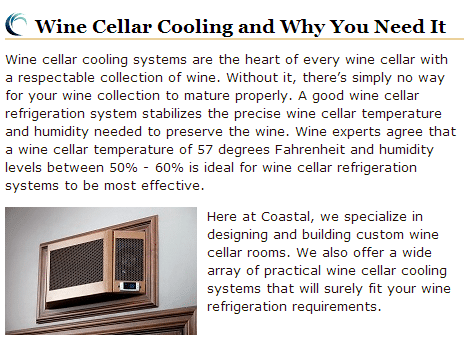 There’s a PDF attachment that Tim should send you it’s titled ‘How to Construct a Wine Cellar’ and we’re actually looking at this wine cellar construction PDF now. All the walls and ceilings must be scaled with a vapor barrier on the warm side.
There’s a PDF attachment that Tim should send you it’s titled ‘How to Construct a Wine Cellar’ and we’re actually looking at this wine cellar construction PDF now. All the walls and ceilings must be scaled with a vapor barrier on the warm side.
The warm side, if you look at this cross section here of a wall, will be the exterior wall or the hot side of the wine cellar; the wine cellar being the cold side or the interior wall here. Within the wall cavity itself, a vapor barrier must be placed on the hot side. This stops warm air and moisture from entering the wine room or the wall cavity, and then ultimately the wine room and stops the moisture.
If there’s no vapor barrier, moisture will creep through the wall cavity through the building materials and ultimately into the wine room where it will come into contact with cool air and thus condensation will form. It will form in the wall cavity itself causing some problems with mold and mildew over time.
In the wine room itself condensation could actually form on the bottles, in the corners, on the paint, on the door hardware, and on any glass structures that are in there like a window maybe. This is very, very important.
The insulation factor that you see here in the middle, which is on the cold side of the vapor barrier, helps retain or keep the cool air in the wine room, as any typical insulation to a home or a business would. I think if you read through this, you will find different ways that these wall cavities can be prepared with vapor barriers and insulations.
There’s actually two ways. There’s the old school way where a 6 mil or 8 mil plastic sheeting is used; and there’s also a more modern technology, it’s a blow in foam expanding insulation that a contractor would actually blow into the wall cavity. It’ll expand, dry, and it is a far more accurate or better way, I should say, although it is a little pricier.
I’m here for any of your questions regarding wine cellar cooling Los 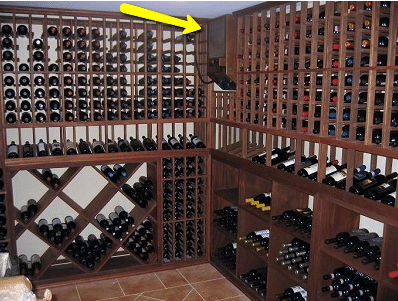 Angeles California. By the way, I wanted to let you know that sometimes folks don’t add wine cellar cooling units at all.
Angeles California. By the way, I wanted to let you know that sometimes folks don’t add wine cellar cooling units at all.
People in the northeast or in any cold climate, and especially if they are in basements or below ground level, it’s typically very cool and appropriate temperatures, so wine cellar climate control units may never actually be added. This is referred to as a passive cellar or it is either naturally cooled or the collector has decided not to cool the wine room for whatever reason.
Just to summarize, it is very important that a wine room be prepared properly for refrigeration. Even if you don’t add the wine cellar cooling unit during the course of wine cellar construction, it’s very important that the wine room itself be prepped properly, so that later down the road the client decides to add a cooling unit, he doesn’t have to tear out the walls and start from square one.
Again, if you have any questions, you may call or send an email. Cheers!

